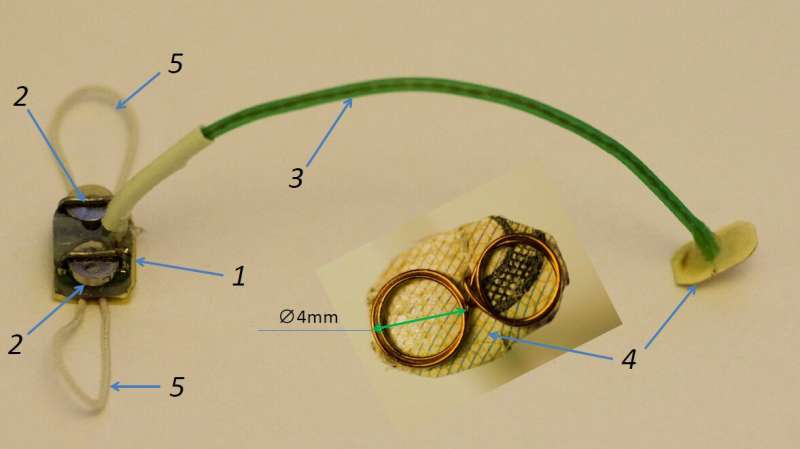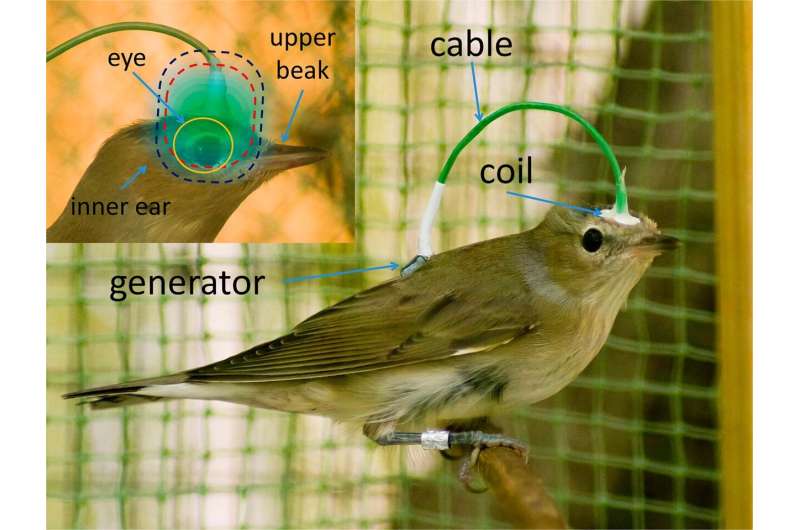Studying the mechanism for avian magnetic orientation

Ornithologists and physicists from St Petersburg University have conducted an interdisciplinary study together with colleagues from Sechenov Institute of Evolutionary Physiology and Biochemistry of the Russian Academy of Sciences and the Biological Station Rybachy of the Zoological Institute of the Russian Academy of Sciences. They have created a micro device, weighing less than a gram, which enables them to disrupt locally the avian magnetic compass. The scientists have discovered that magnetoreception in birds is unlikely to be associated with the light-sensitive protein cryptochrome in the retinas of their eyes, though photochemical reactions in cryptochrome have been so far considered to be the primary biophysical mechanism behind the magnetic sense of birds.
At present, researchers are puzzled by the mechanism of avian magnetic orientation, which allows migratory birds to solve the complex tasks of moving between distant breeding and wintering grounds. The existence of a magnetic compass system in birds has been well documented, but the sensory mechanism and its location still remain unknown. What is known is that birds use multiple sources of directional information for their navigation: the sun, stars, landscape, smells, as well as parameters of the Earth's geomagnetic field. Birds can use the geomegnetic field to maintain the flight direction (magnetic compass) and, possibly, to determine their location (magnetic map). It was also established that the avian magnetic compass can be disrupted if the whole body of the bird is exposed to a weak oscillating magnetic field (OMF) in the megahertz range. Furthermore, in 2018, an international team of researchers, which included scientists from St Petersburg University, found that magnetic map information is transmitted to the brain of the bird through the ophthalmic branches of the trigeminal nerve. Thus, the functions and certain neural pathways are known, yet the receptor itself has still not been found.
According to one of the theories explaining the unique ability of migratory birds, the most probable magnetoreceptors are molecules of a photosensitive protein, the cryptochrome. These are located in the retina of the bird's eye. The outcome of the photochemical reactions inside the magnetically sensitive protein depends on intensity and direction of the magnetic field. Some researchers suggest that the cryptochromes in birds' eyes give them an ability to 'see' the Earth's magnetic fields. To check whether the avian magnetic compass is really embedded in the visual system, the researchers from St Petersburg University decided to apply OMF locally to the bird's eyes.. Theoretically, this should have disrupted the bird's orientation.
"We have developed miniaturised devices, each weighing just 0.95 grams and comprising a magnetic coil and a high-frequency generator fed from watch batteries," explained Kirill Kavokin, Leading Scientist of the I.N. Uraltsev Spin Optics Laboratory at St Petersburg State University. "Since the coils are very small, the magnetic field can be applied locally only to the bird's eyes. It was a challenge to construct such a device. Besides, we spent a lot of time selecting a non-toxic adhesive that would be safe for birds and provide reliable bonding. This turned out to be an eyelash glue."

Twenty-two Garden warblers were equipped with portable devices, with the magnetic coil attached to the bird's head. The Garden warbler is a widespread small bird that breeds in most of Europe and spends the winter in Africa. The experimental birds were captured during the autumn migration at the Biological Station Rybachy on the Courish Spit, Kaliningrad region, Russia. After a series of experiments, it was determined that the birds with portable devices attached, both in 'on' and 'off'state, behave the same way. The birds were tested in round arenas placed inside a screened and grounded non-magnetic chamber with artificial nocturnal lighting by green LEDs. Under these conditions, the only orientation cue available to the experimental birds during the tests was the geomagnetic field. The birds, however, were not disoriented and showed the seasonally appropriate migratory direction—southwest. On the contrary, when placed in an OMF generated by large stationary coils in control experiments, the birds demonstrated clear disorientation.
"Our findings cast doubt on the prevailing photochemical theory of the magnetic compass of birds. They point to the existence of other components of the avian magnetoreception system that are sensitive to OMFs. These findings challenge the existing ideas about the biophysics and neurophysiology of magnetoreception."Julia Bojarinova, one of the leading authors of the research, Associate Professor of the Department of Vertebrate Zoology at St Petersburg University
In further experiments, the scientists seek to explore other places on the bird's body where the compass receptor may 'hide itself.' According to available data, such a receptor might be situated either in the upper beak, or in the lagena—part of the bird's inner ear. To test new theories, experimenters will be able to utilise the developed miniaturised devices—only slight modifications of the magnetic coils will be required.
"At present, our interest is mainly fundamental. We are driven by curiosity, as the magnetic compass of birds remains the unsolved puzzle," noted Kirill Kavokin. "Nonetheless, there is a chance that the solution of this fundamental problem will enable the creation of new satellite-free navigation systems." After all, birds always know where to fly, and they do not need satellites for navigation."
More information: Julia Bojarinova et al, Magnetic compass of garden warblers is not affected by oscillating magnetic fields applied to their eyes, Scientific Reports (2020). DOI: 10.1038/s41598-020-60383-x
Journal information: Scientific Reports
Provided by St. Petersburg State University



















